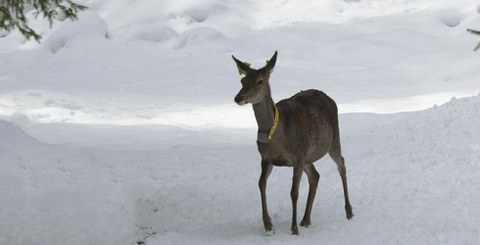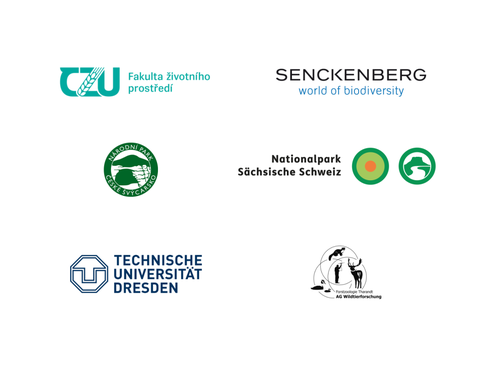Jun 20, 2024
The REDEMA project will enable transboundary research on deer in the Bohemian and Saxon Switzerland National Parks

Red deer with telemetry collar
This press release is also available in the Czech language version.
The red deer is the focus of the new Saxon-Czech research project Improving the effectiveness of red deer management through cross-border approaches (REDEMA), which will take place for three years in the Bohemian Switzerland and Saxon Switzerland National Parks.
Researchers from the Czech Agricultural University in Prague (ČZU), the Senckenberg Society for Nature Research, both national park administrations and the TUD Dresden University of Technology will jointly assess the condition and factors influencing the red deer population as a common wild animal in the region. It will focus on the impact of red deer and other ungulates on the restoration of the local forest, which is undergoing fundamental change. This includes spruce dieback and the consequences of forest fires, but also the influence of wolves.
The project, funded by the EU Interreg Saxony - Czech Republic 2021-2027 program (EU ERDF funding) with €1,212,100.92, will enable both national parks to conduct joint research on the topic and subsequently implement joint wildlife management for wild ungulates. The duration of the project is 09.03.2023 - 31.12.2026.
The partners of the Saxon and Czech institutions officially launched the project "Improving the effectiveness of red deer management through cross-border approaches (REDEMA)" at a joint meeting in Bad Schandau on Friday, March 15, 2024.
"Locally, the red deer is the largest herbivore in Central Europe; at the same time, it is assumed that the number of deer in both national parks is steadily and disproportionately increasing. Young forest trees are one of their preferred foods. An increase can limit the regeneration of forest stands, which is particularly the case in the heavily disturbed ecosystems of Bohemian-Saxon Switzerland, i.e. in bark beetle and burnt forests. Although these are national parks, we find a complex system of problems here: Forest stands do not yet have a natural composition everywhere, their regeneration is deteriorating, rocky sites are drying out extremely due to climate change, forest fires are on the rise, visitor numbers are increasing and the dominant predator - the wolf - has returned here. The red deer population plays a central role in this system, and in our project we will try to harmonize all the expected functions of both protected areas," said Aleš Vorel, project coordinator from the Faculty of Environment of the Czech Agricultural University in Prague.
Vendula Meißner-Hylanová from the TUD Dresden University of Technology described the research potential of the collaboration: "Achieving our goal of tagging 15 red deer with telemetry collars will give us a detailed insight into the activities and changes in the spatial distribution of this ungulate in the Saxon Switzerland National Park. Together with our Czech colleagues from Miloš Ježek's team from the Faculty of Forest and Wood Sciences at ČZU, we can apply the same monitoring techniques throughout the project area. Taking into account four other large-scale projects in Saxony and Bavaria, this will improve our knowledge of the ecology of the red deer."
Hanspeter Mayr, Press Officer of the Saxon Switzerland National Park, assessed the project's contribution positively: "By participating in the project, the Saxon Switzerland National Park receives valuable information about the red deer population and the factors of tourism, wolves and hunting that can influence red deer movements in the area. Based on this information and monitoring of forest growth, we will be able to adapt red deer management in a cross-border context and increase its effectiveness. We are also looking forward to the joint cross-border cooperation with all project partners and hope for a long-term joint cooperation starting with this INTERREG project REDEMA."
Tomáš Salov, Press Officer of the Bohemian Switzerland National Park, appreciates the beginning cooperation: "The joint data collection and thus easily comparable results should enable decision-making in red deer management so that the procedures on the Czech and Saxon sides of the border are close or even uniform. The issue of optimal management of red deer is also important because their populations can have a major impact on the development of regenerating forest stands, which are currently in a very sensitive phase of development."
Project coordinator Catriona Blum-Rérat from the Senckenberg Gesellschaft für Naturforschung added: "Our Institute in Görlitz will investigate the role of predators on both the Saxon and Czech sides. We are analyzing the composition of the prey in the wolf carcasses found and we are checking the health and age of the wild animals (roe deer and red deer) that were captured. In a comparative analysis, this data can be used to compare the wild animals captured by wolves with those from hunting. From this, we can draw conclusions for adjustments in roe deer and red deer management for both national parks."
As lead partner of the consortium, the Faculty of Environment at ČZU in Prague has long been dedicated to monitoring large mammals. In the Czech Republic, it monitors in particular the return of wolves and their impact on ungulate populations in the vicinity of the German-Czech border. The REDEMA project, funded by the Interreg program Saxony - Czech Republic 2021-2027, is partly a thematic continuation of the OWAD project (2018-2020).
Summarized information on the projects can be found on the website Research and monitoring of wolves.
Project REDEMA umožní přeshraniční výzkum jelení zvěře v Českém a Saském Švýcarsku
Jelen evropský je hlavním objektem zájmu nového česko-saského výzkumného projektu Zvýšení účinnosti managementu jelení zvěře pomocí přeshraničních přístupů (REDEMA), který se po dobu tří let uskuteční v národních parcích České Švýcarsko a Saské Švýcarsko. Výzkumníci z České zemědělské univerzity v Praze, Senckenbergské přírodovědné společnosti, správy obou národních parků a Technické univerzity v Drážďanech společně vyhodnotí stav a faktory ovlivňující populaci jelenů coby nejpočetnějšího kopytníka na území. Zaměří se také na vliv jelenů a dalších kopytníků na obnovu tamního lesa, jenž prochází zásadní obměnou zahrnující odumření smrků, následky požáru ale i návrat vrcholových predátorů - vlků.
Projekt financovaný z programu EU Interreg Sasko - Česká republika 2021-2027 (prostředky z ERDF EU) ve výši 1 212 100,92 EUR umožní oběma národním parkům provádět společný výzkum na dané téma a následně společný management volně žijících kopytníků. Doba trvání projektu je od 09.03.2023 do 31.12.2026.
Partneři z českých a saských institucí projekt nazvaný "Zvýšení účinnosti managementu jelení zvěře pomocí přeshraničních přístupů (REDEMA)" oficiálně zahájili v pátek 15. března 2024 na společném setkání v Bad Schandau.
"Jelen evropský je místně největším herbivorem střední Evropy, zároveň se předpokládá, že jeho stavy v obou národních parcích neustále a neúměrně přibývají. Vzhledem k tomu, že mladé stromy jsou jejich preferovanou potravou, může tento růst limitovat obnovu lesních porostů, což zvláště platí v silně narušených ekosystémech Česko-saského Švýcarska, tedy kůrovcových a vypálených lesů. Přestože jde o území národních parků, nacházíme zde komplikovaný systém problémů - lesní porosty ještě nemají všude přirozenou skladbu, zhoršuje se jejich obnova, skalní města v důsledku klimatických změn extrémně vysychají, přibývá lesních požárů, roste návštěvnost a vrátil se sem dominantní predátor - vlk. V tomto systému hraje ústřední roli populace jelena, a v našem projektu se budeme snažit vybalancovat všechny očekávané funkce obou chráněných území," řekl Aleš Vorel, vedoucí projektu z Fakulty životního prostředí ČZU v Praze.
Výzkumný potenciál spolupráce popsala Vendula Meißner-Hylanová z Technické univerzity v Drážďanech: "Dosažení našeho cíle, opatření 15 jelenů telemetrickými obojky, nám poskytne zevrubný vhled do aktivity a změn prostorové distribuce tohoto nejpočetnějšího kopytníka v národním parku Saské Švýcarsko. Společně s českými kolegy z týmu Miloše Ježka z Fakulty lesnické a dřevařské ČZU budeme schopni aplikovat stejné monitorovací techniky na úrovni celé krajiny projektového území, což s přihlédnutím k dalším čtyřem rozsáhlým projektům v Sasku a Bavorsku zdokonalí naši znalost ekologie jelena evropského."
Hanspeter Mayr, tiskový mluvčí NP Saské Švýcarsko hodnotí přinos projektu pozitivně: "Účastí v projektu získáme cenné informace o populaci jelena a faktorech cestovního ruchu, vlků a lovu, které mohou ovlivnit jeho pohyb v projektové oblasti. Na základě těchto informací a monitoringu obnovy lesa budeme schopni přizpůsobit hospodaření s jelenem v přeshraničním contextu a zvýšit jeho efektivitu. Těšíme se také na společnou přeshraniční spolupráci se všemi partnery a doufáme, že navážeme dlouhodobou společnou spolupráci, která tímto projektem začíná."
Začínající spolupráci oceňuje i Tomáš Salov, tiskový mluvčí NP České Švýcarsko: "Společný sběr dat a dobře porovnatelné výsledky umožní rozhodování při péči o jelení zvěř tak, aby postupy na české i německé straně hranice byly blízké či dokonce jednotné. Téma optimální péče o jelení zvěř je důležité i proto, že její početní stavy do značné míry mohou ovlivňovat vývoj obnovujících se lesních porostů, které se právě nacházejí ve velmi citlivé části vývoje."
Projektová koordinátorka Catriona Blum-Rérat ze Senckenbergské přírodovědné společnosti doplnila: "Náš institut ve Zhořelci bude zkoumat roli predátorů na saské i české straně. Zanalyzujeme složení kořisti v nalezených vzorkách vlčího trusu a u stržených divokých zvířat, srnců a jelenů, kontrolujeme zdravotní stav a věěk. Ve srovnávací analýze lze za použití těchto dat porovnat vlky strženou zvěř s tou ulovenou lovci. To nám umožní vyvodit závěry pro úpravy v managementu srnčí a jelení zvěře pro oba národní parky."
Fakulta životního prostředí ČZU v Praze, coby vedoucí instituce konsorcia, se dlouhodobě věnuje monitoringu velkých savců, v Čechách zejména sleduje návrat vlků a jejich vliv na populace kopytníků právě v oblasti česko-německého pohraničí. Project REDEMA financovaný z programu Interreg Česko-Sasko 2021-2027 tematicky částečně navazuje na projekt OWAD (2018-2020). Souhrnné informace k projektům naleznete na webu wolf.czu.cz.


